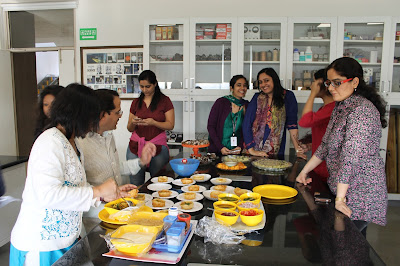Managers can't be leaders for the very fact that they are tied to processes, and processes are the dry and repetitive patterns of boxed up thought processes that curb creativity and divergent thinking! If Martin Luther King had a dream, then it was about the unexpected emancipation of the African Americans who were living in America. Who would have dreamt that African Americans would one share equal rights with their white counterparts? On the Indian sub continent, no one would have imagined that non violence and civil disobedience would triumph in Champaran!
The fact is that today all of us are slaves to processes and none of us dare to go beyond them. It takes a lot of courage to break free form the processes, rules and regulations set before us by our predecessors. In many ways, we procrastinate and are lazy when we follow processes. We don't want to be the change, nor are we ready to stick our heads out for fear of being on the receiving end!What marks leaders apart from managers is that they have the sheer courage to look beyond processes, accepted trends and popular beliefs. This is exactly what Gandhi did when he decided to experiment with non-cooperation, satyagraha and non-violence in Champaran. What mattered was that Gandhi succeeded brilliantly, and he was able to teach the peasants of Motihari a lesson in courage.
What marks managers apart from leaders is the fact that the latter are able to think out of the box, while the former can only work within a tight framework of constraining rules and regulations. Great leaders are visionaries and dreamers who are able to think about solutions that go beyond processes. They are people who can inspire dreams that fuel hope. Gandhi was able to encourage the peasants of Motihari to dream of a world where they had rights, a world where they had champions to fight for them a world where no one could order them about.
When it became clear that there were very strong chances that Gandhi would have to go to jail in Motihari, the lawyers who were supporting him thought about returning to their work in their hometowns. I very strongly believe that the lawyers who supported Gandhi were more of managers than visionaries. They told Gandhi during the Champaran episode that if he went to jail, they would return to their practices. Gandhi like a true leader did not argue with them, rather he asked them one question, and that was pertaining to what would happen to the share croppers in his absence and their absence.
The fact is that strong leaders will combine vision and dream with an awareness of processes that drive accomplishment. Gandhi as such kept a constant link (while he was in Champaran) with his ashram in Gujarat, and he told his people to dig new trenches for the toilets much before the old ones were filled to their capacity. Nelson Mandela had a vision for South Africa which was based on equality between the white settlers and the native Africans. He dared to dream big and it was about a South Africa. Talking about dreams reminds one about the Emancipation speech that was delivered by Martin Luther King (junior) on the 28th of August, 1963 at the Lincoln Memorial, Washington D.C. in which he referred to a 'dream' a vision that he had for African Americans:
Let us not wallow in
the valley of despair, I say to you today, my friends.
And so even though we
face the difficulties of today and tomorrow, I still have a dream. It is a
dream deeply rooted in the American dream.
I have a dream that
one day this nation will rise up and live out the true meaning of its creed:
"We hold these truths to be self-evident, that all men are created
equal."
This brings me back to the question about what constitutes a Manager if he or she is not a leader then? The word, 'Manager' is a very general and vague term. The Merriam Webster Dictionary lists, 'administrant, administrator, director, executive, superintendent, supervisor' as synonyms for the word Manager. The legal definition of Manager, according to the dictionary is, 'a person who manages a business or organisation.'So in an organisation, the person who looks after the estate and property is the 'Estate Manager', and his duties might include the repair of furniture, purchase of computer peripherals, overseeing security, and security related issues and so on. The confusion between the role of the Manager and the role of the Principal becomes confusing when one switches from one school to another. In a Government Aided schools in India, the Manager is the appointing authority, while in Diocesan schools in India, the Chairman of the group of schools is the appointing and dismissing authority. The role and position of a Manager in a Government Aided school is higher than that of the Principal whereas the position of a Manager in a Diocesan school might be lower than that of the Principal. The question then is that does the power of appointing and dismissing personnel from the organisation make the Manager a leader? Does the Manager's ability to sanction funds, or for that effect, make purchases for the organisation make him a leader? I guess the answer to both the questions would surely be in the negative. The executive role of the Manager simply does not allow for leadership roles of sharing dreams or visions! A Manager cannot afford to be a dreamer lest he should make serious mistakes in the income and expenditure accounts of the organisation.
In the Corporate sector too, the term, 'Manager,' is a much bandied term, and in many cases a more sugarcoated term for 'Executive,' a pen-pusher who handles the back office for boys and girls who are away in the field. The Manager in such firms might even be a contact person for a floating population of executives who rarely meet or come together at the same time.These roles however doesn't take away from efficient Managers their exceptional abilities in handling accounts and yet be kind and helpful in nature. In some cases their strictness and meticulous nature have helped craft 'go getters,' and 'dynamic' professionals who have risen high up in the corporate ladder. Managers who are forced into leadership roles will however rarely be able to lead a team, unless, of course they have the talent and skills to take up such a role. The manager of a DSA that handles credit cards has to be a tough task master; he or she might be forced to drive sales and this might be possible through an arsenal of tough words, harsh reprimands, and the weekend appraisal meetings which leave the poor executive smarting with shame!The choicest of invectives, and harsh reprimands might drive sales in the short run, but the long term impact is that you lose valuable personnel through unacceptable high rates of attrition.
This article is however not intended to disparage the importance of Managership, which in many cases are indispensable. A lot of good managers are doing yeoman service and they have stepped into leadership positions in the interim during times of difficult.The roles of Managers and Leaders are however different.Many will agree that this is because while the manager has a steadying effect the leader has a disruptive influence. Leadership is about leading the team for a long period of time, it is about bringing about intrinsic motivation in the team. Leadership is about making each team member gladly align his or her goals and ambitions with those of the organisation. Leadership however takes over from Managership, and although both appear to be poles apart, they are however strongly interdependent!
www.americanrhetoric.com/speeches/mlkihaveadream.htm
www.merriam-webster.com/dictionary/manager












































